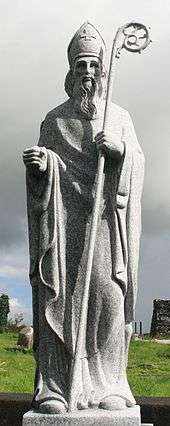Tírechán
Tírechán was a 7th-century Irish bishop from north Connacht, specifically the Killala Bay area, in what is now County Mayo.

Background
Based on a knowledge of Irish customs of the times, historian Terry O’Hagan has concluded that Tírechán was probably from a wealthy, elite family. Sometime in the 650s, he was sent to Ardbraccan in County Meath as a “fosterling” and student of Ultan, bishop of Ardbraccan. References to numerous geographical areas and to sites such as holy wells, cemeteries, crosses, and churches have led O’Hagan to call Tírechán one of the most “widely travelled” of early medieval writers.[1]
Works
Tírechán is best known for “Collections,” writings about St. Patrick which have been preserved in the Book of Armagh. The narrative is presented in the first person, as if Patrick himself were the narrator. To research his subject, Tírechán read and interviewed Ultan, and studied the “Confessio” of St. Patrick, the work “Commemoratio Laborum,” and narratives in the oral tradition passed down from “seniors” and “wise ancients.” He seems to have been motivated not only by his esteem for the saint, but also by indignation at the attacks on Patrick’s successors and representatives, the coarbs, perpetrated by “deserters and robber chiefs and soldiers” in Armagh.[2]
In addition, Tírechán has been credited as the author of the anonymous Catalogus Sanctorum Hiberniae, which is considered a worthy source of information about early Christianity. However this is unlikely as Grosjean dates it to c.900.[3] Likewise, another of his works, entitled "Tripartite Life," provides information about St. Tigris, the sister of St. Patrick.[4][5]
Historians have also used Tírechán for knowledge of the Gaelic manner of dating Easter[4] and the chronology of Irish Christianity. For example, he gave the date of St. Patrick’s death as 469, twenty-five years distant from the commonly assigned date of 493.[6]
In addition, the quality of his work is considered reliable enough to serve as a standard of comparison with other primary sources of the period, such as the Acts of St. Ailbe.[7]
Tírechán wrote in Latin, and historian Terry O’Hagan indicates that Tírechán’s work should be considered “a work in progress” in that he probably died before his work was complete. His work is often compared to that of his contemporary, Muirchú, who wrote Vita Sancti Patricii (Life of St. Patrick).[1][8]
Floruit
Historians have dated Tírechán’s work to the second half of the seventh century based on the date of his tutor’s death (656) and references in his works to events known to have occurred in that period—e. g., plagues, ecclesiastical controversies, and the warring of Irish dynasties. Considering these elements, O’Hagan has placed Tírechán’s active period between 664 and 684.[1]
References
- O'Hagan, Terry. "Tírechán: Biography and Character Study". Saint Patrick's Confessio. Royal Irish Academy. Retrieved 4 July 2017.
- Olden, Thomas, ed. (1885–1900). Dictionary of National Biography, Vol. 56. London: Smith, Elder & Co. p. 414. Retrieved 4 July 2017.CS1 maint: extra text: authors list (link)
- 'Edition et Commentaire du Catalogus Sanctorum Hiberniae Secundum Diversa Tempora ou de Tribus Ordinibus Sanctorum Hiberniae', by Paul Grosjean
- Henry Jenner. "The Celtic Rite". Catholic Encyclopedia. New Advent. Retrieved 4 July 2017.
- William Grattan-Flood. "St. Tigris". Catholic Encyclopedia.
- Tirechan.
- "The Life of St. Ailbe". Catholic Encyclopedia.
- Dawson, Elizabeth. "Pillars of Conversion in Muirchú and Tírechán: Two Case Studies". St. Patrick's Confessio. Royal Irish Academy. Retrieved 4 July 2017.
External links

- St Patrick's Confessio HyperStack: The website provides images of the Patrician Texts in the Book of Armagh, Tírechán's Biography of St Patrick in Latin and English.